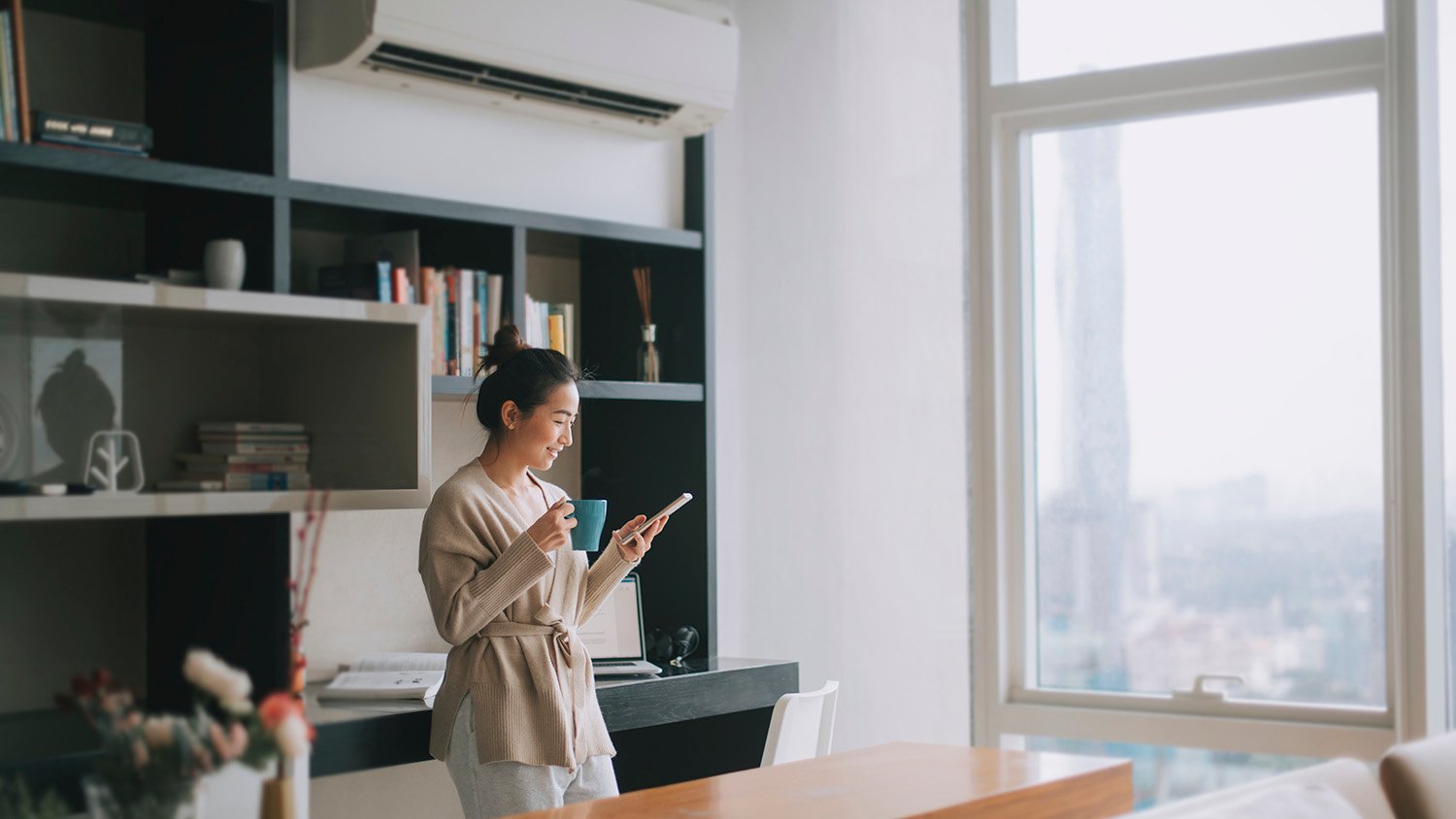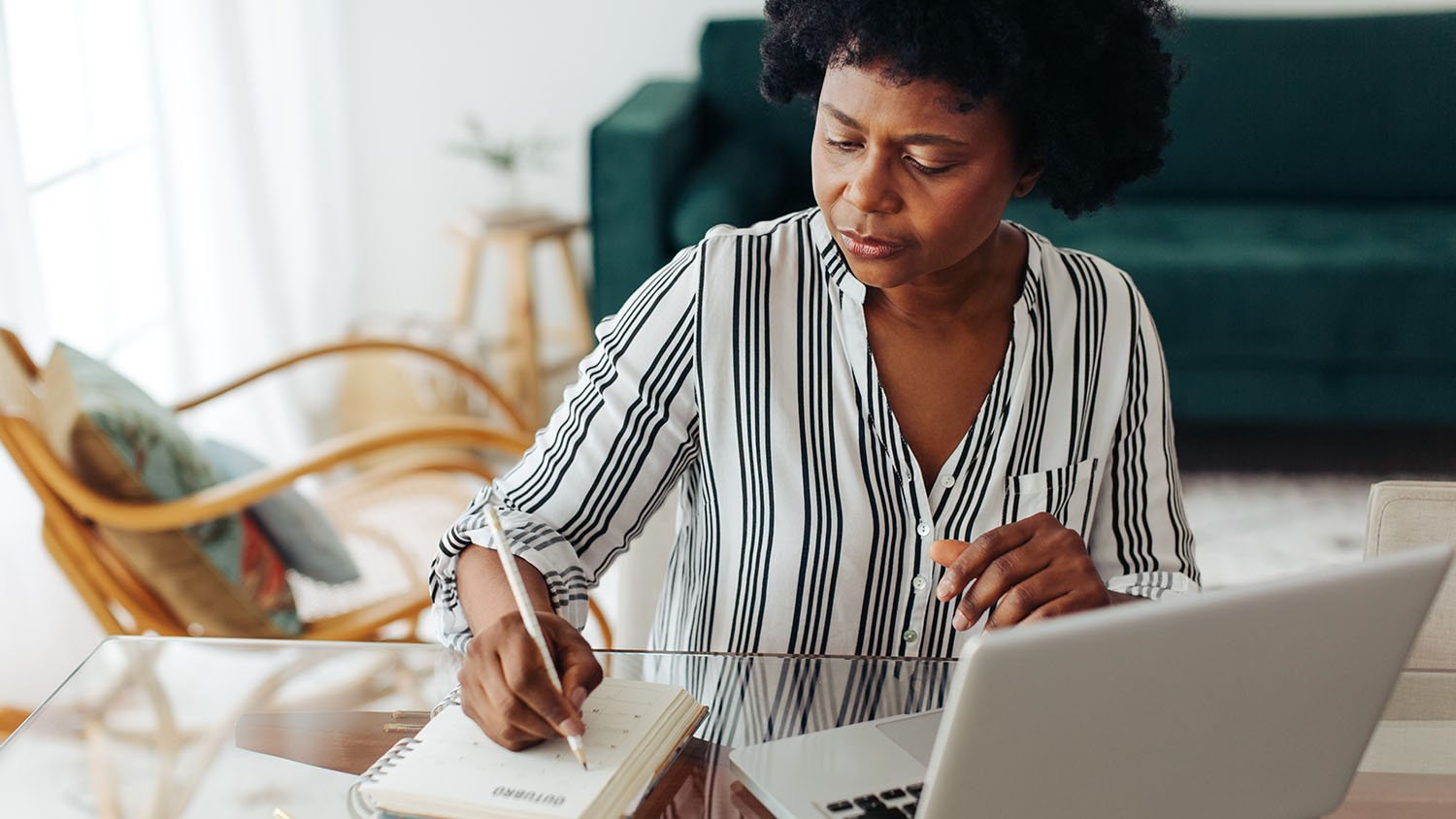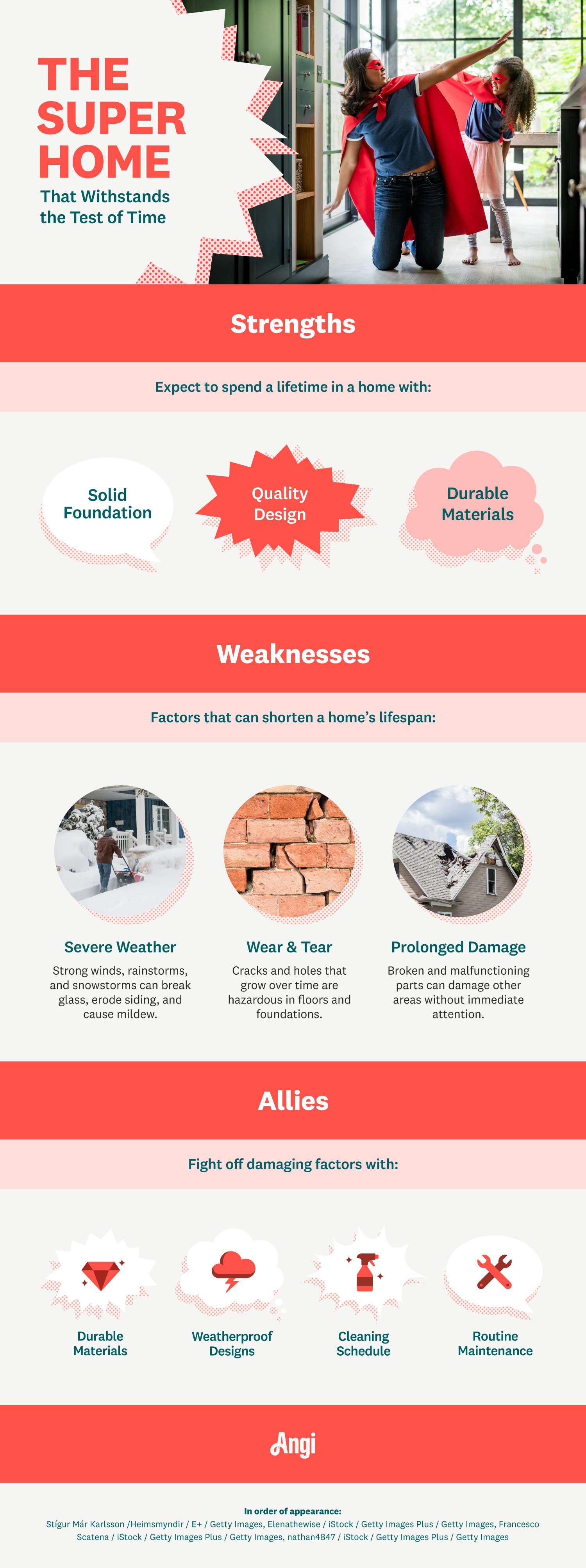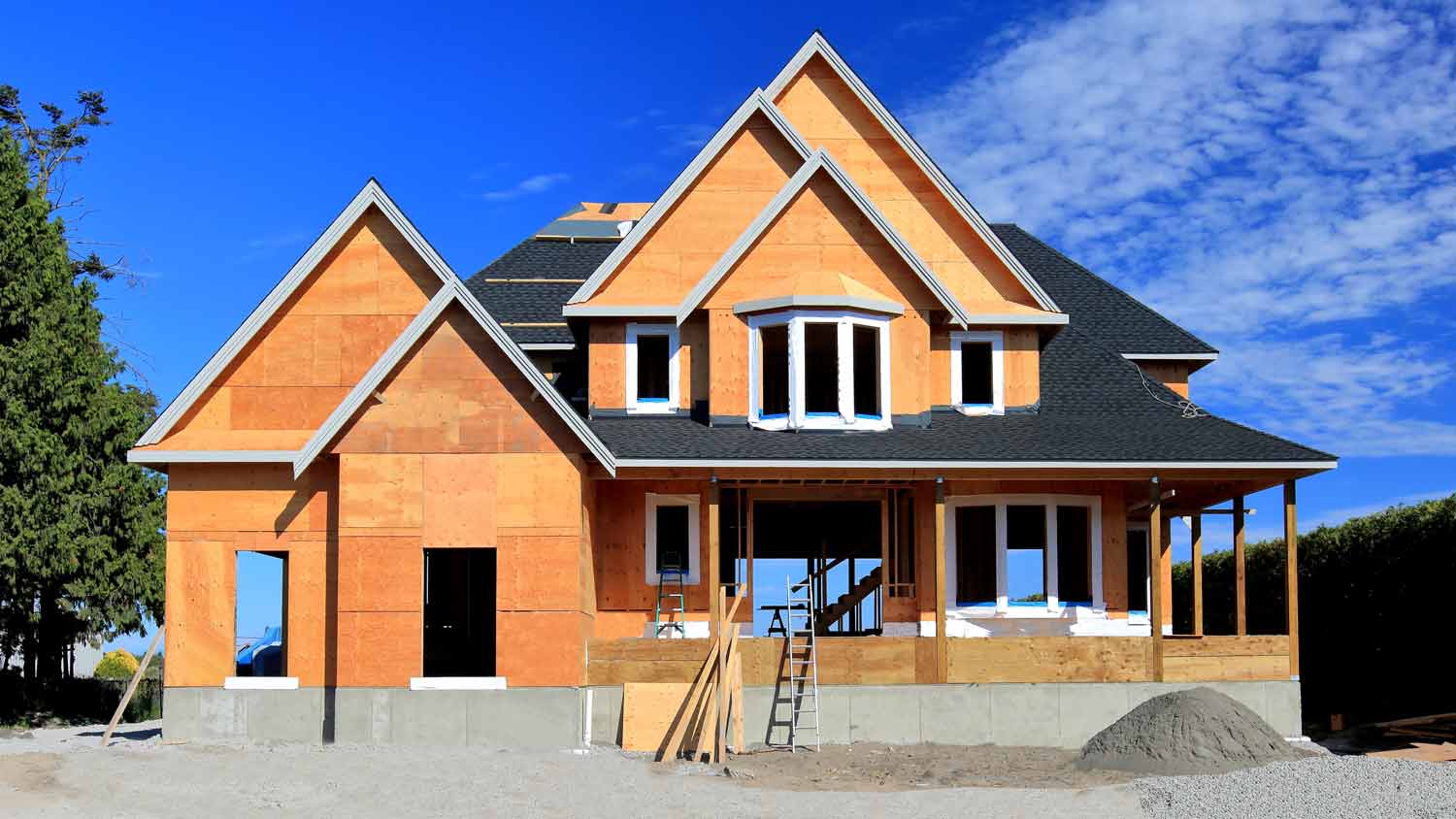
Brick walls can add character and elegance to interior and exterior spaces. Use this brick wall cost guide to see the price range for adding one to your home.
The average home lasts 70–100 years, and longer with routine repairs


The average lifespan of a newly constructed house is 70–100 years.
Factors such as weak housing materials and damaging weather exposure can shorten a home’s lifespan.
Routine repair and maintenance can improve the longevity of a home.
Whether purchasing a turnkey home or investing in a fixer-upper, one thing’s for sure: both types will need routine repair and maintenance over time. Scheduling upkeep may have you wondering how long a house will last without it.
While the average home can last up to a century, many factors such as foundation and severe weather conditions can impact its overall life expectancy.
Before embarking on a to-do list, learn the average lifespan of different areas of the home and ways a local home repair professional can help expand them.

The foundation of a home typically has an average lifespan of up to 100 years. Wear and tear over time is normal, including cracks and holes, which minor repairs would help prevent.
The type of foundation also plays a role in longevity, as some are more susceptible to damage than others:
Lasts 100+ years
Cracks may indicate water damage
Lasts 60+ years
Rotting wood is a sign of water damage or termites
Lasts 65+ years
Horizontal cracks can indicate soil movement or deterioration
The average cost to repair a foundation is $4,500 and up, making it one of the more expensive home maintenance services. As a preventative measure, you can consult a local foundation repair contractor for periodic inspection and solutions.
The structure of a house is a combination of elements that, although generally durable, can wear out over time. Additionally, a poorly designed home deteriorates faster, thus the importance of having regular home inspections.
Here’s a look at the anatomy of the average home and lifespan, including costs to keep it in tip-top shape:

On average, a roof lasts 30 years. Keeping the gutters clean and periodically power-washing will help prolong your roof’s life. You can also find a roofing contractor in your area to inspect for signs of damage regularly, especially after a major storm, and fix minor problems.
Drywall, the default of most interior walls, can last 30 to 70 years. It is, however, susceptible to mold, water, and termite damage, with average drywall repair costs around $500.
Unless manually broken or burst from severe weather damage, windows generally last up to 20 years. Broken seals are common (which can affect your energy bill) and a sign of repair needs. To avoid this, check for cracks in the seals several times a year.
While structurally installed floors can last a lifetime, floor coverings such as laminate or carpet usually last 10 to 25 years. Creaks, rotting wood, or sagging spots are problems that need fixing, where the average floor repair costs $400.
The average house siding lasts 20 to 40 years, with material types each having their own pros and cons. Minor repairs such as sealing holes or filling cracks run between $200 and $500, much less expensive than fully replacing siding, which can be $4,000 or more.
A front door can last up to 30 years or more with biannual maintenance, such as fixing dents or holes, at about $225. The material of the door is also a strong factor:
Steel: 30–100 years
Glass: 50–100 years
Wood: 20–30 years
Fiberglass: 30–70 years

Routine maintenance of internal fixtures in your home is just as important, if not more, than the exterior. Let’s take a look at significant areas.
Most home insulation types are long-lasting and not of too much concern for maintenance, though you should replace your insulation if you notice a change in your energy bill. Below are common types and their expected life:
Cellulose: 20–30 years
Spray foam: 80 years
Mineral wool: 100 years
Fiberglass: 80–100 years

To improve HVAC longevity, change the air filters regularly. This helps to avoid blocking airflow and overworking the motor. Also, hiring an HVAC professional near you to service regularly can prevent damage and save money in the long run. Where HVAC tune-up costs range from $160 to $500, replacing HVAC systems can cost around $7,500.
Furnace: 15–20 years
Air conditioner: 10–15 years
While most plumbing fixtures and pipes have a life expectancy of 20 to 100 years, consistent drainage issues and low water pressure are indications it’s time for a replacement.
Copper: 50–100 years
Galvanized steel: 20–50 years
Cast iron: 50–100 years
Brass: 20–50 years
Most household appliances last up to 20 years, and even longer with proper care and upkeep. While replacing an appliance can cost between $350 and $8,000, average maintenance is a fraction of the cost:

Regular surface-level cleaning and occasional deep cleanings can make kitchen appliances last longer. Also, opt for stainless steel appliances if it’s within your budget. Though more expensive, stainless steel is much more durable than white ceramic versions.
As for washers and dryers, consider purchasing them as a set. This way, they’ll run at the same capacity with similar efficiency levels. Be careful not to overload them, which can damage the machines.
While annual inspections are an effective way to avoid expensive home repairs down the line, the secret to a long-lasting home is taking care of it.
Here are four ways you can do your part to prolong the life of your property:
When designing your living space, it’s important to compare material options and learn the pros and cons of each. Stainless steel, for example, is rust and water-resistant, making it more a durable option for appliances and fixtures.

A practical way to stay on top of tasks and keep to-dos in order is through a home maintenance checklist. This list allows you to organize and schedule necessary repairs monthly, seasonally, and annually in advance.
The climate of where you live also plays a part in material durability. For example, metal fixtures aren’t ideal for coastal areas, as they can corrode from the saltwater. This is why weatherproofing your home is a must, especially if your residential area is prone to natural disasters.

Last but not least, a clean home is a happy home. If not cleaned regularly, dirt and grime can, and will, accumulate on appliances and throughout the house, contributing to wear and tear.
Be sure to budget for repair and maintenance. Keeping potential repairs in mind can save you thousands of dollars in replacement costs. If you eventually decide to buy a new property or sell your home, a home inspector in your area can help suss out those important repair needs.

From average costs to expert advice, get all the answers you need to get your job done.

Brick walls can add character and elegance to interior and exterior spaces. Use this brick wall cost guide to see the price range for adding one to your home.

When your home project requires a professional at the helm, how much are construction management fees, and how do they determine their rate? Let's break it down.

Curious how much general contractors charge per hour? Discover hourly rates, key cost factors, and tips to save on your next home project.

Learn about the pros and cons of hiring a general contractor to handle your home renovation project and why research to find the right one matters.

What is included in framing a house? This process involves framing the floors, walls, and roof. Contractors must follow a detailed building plan for success.

If you’re short on space, pocket doors aren’t your only option. Explore these 12 pocket door alternatives.